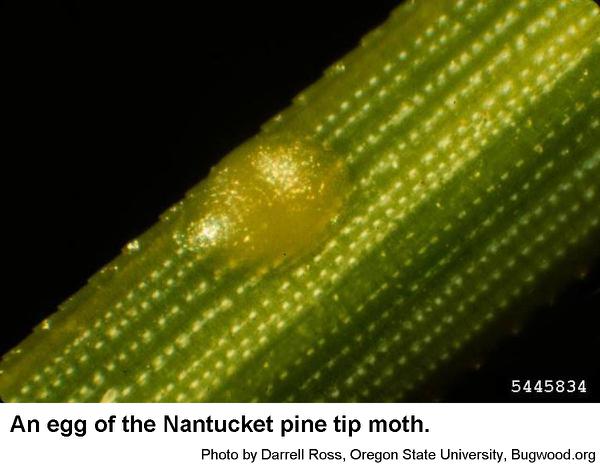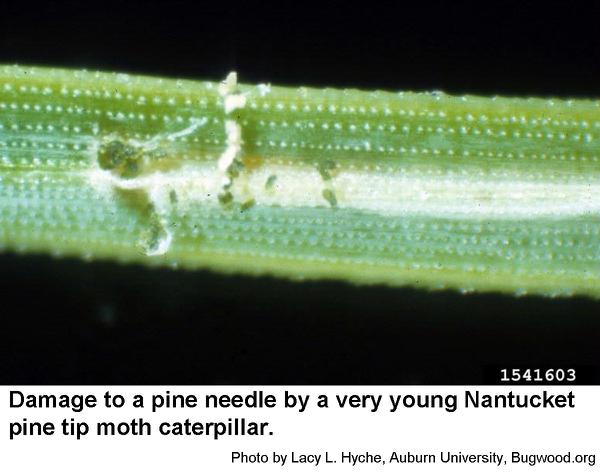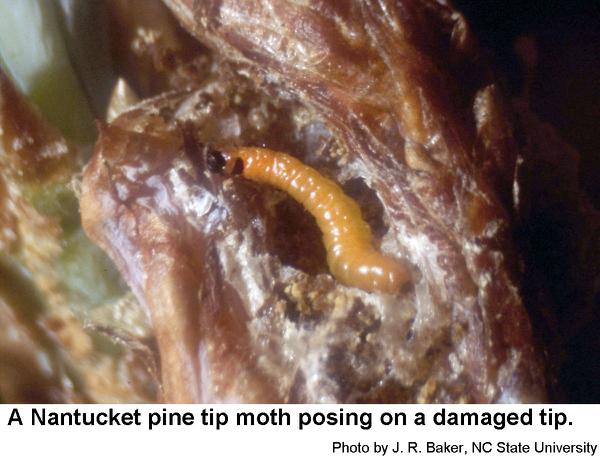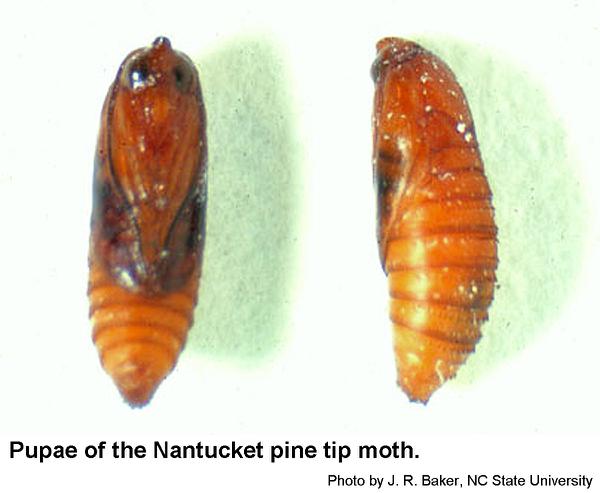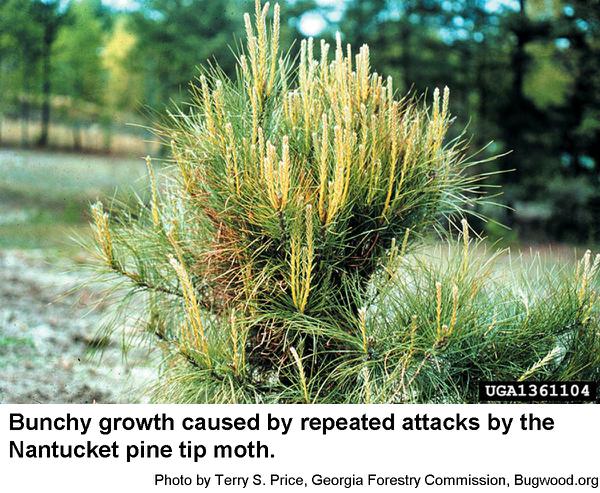Description and Biology
Nantucket pine tip moths, Rhyacionia frustrana, are about 1/4 inch long with a wing span of about 1/2 inch. They are copper colored with silvery markings. The eggs are very small, convex, and white to orange. Their 3/8 inch long caterpillars are usually cream colored with brown heads. Pupae are brown to dark brown, fusiform, and about 1/4 inch long. The Nantucket pine tip moth is an important pest of piine plantations. Here in North Carolina, this pest overwinters as pupae in hollowed out pine shoots. On warm days as early as January and February, new moths emerge to mate. Females lay eggs on needles, stems, and buds. Depending on the weather, 5 to 30 days later, tiny caterpillars hatch and feed on the surface of new growth or they bore into the needle bundles. Later they migrate to the shoot tips, construct protective webs at the base of buds, and begin to bore into the bud or stem. Feeding continues inside until the caterpillars are fully grown in 3 to 4 weeks. The caterpillars then pupate inside the damaged stem. Here we have at least three generations each year.
Host Plants
Long leaf and eastern white pines are resistant to Nantucket pine tip moths, and slash pine is rarely attacked. All other pines seem to be susceptible. In North Carolina, loblolly and shortleaf pines are particularly favored hosts. Boring into the tips causes slower growth, crooking and forking of main stems, reduction of cones, and in extreme cases, death of young trees. Most attacks occur on trees up to 15 feet tall. Rarely, wide spread damaging infestations have been reported in larger trees.
Residential Recommendations
More than 30 species of parasites attack the Nantucket pine tip moth as well as several predatory insects and even birds. Only when these natural control agents fail will it be necessary to apply an insecticide. A good way of timing sprays for this pest is to put some infested tips into a dry plastic bag and keep them in the shade. When the first little, coppery-silvery moth is seen, then the trees should be sprayed 10 days later. This 10 day waiting period allows the moths to emerge, mate and lay eggs and the eggs to hatch. That way, the pesticide is applied when the caterpillars are in their most vulnerable state. One of the Bacillus thuringiensis pesticides, pyrethroid insecticides, or Sevin should be applied 8 and 12 days after the first moths are noticed to obtain good control. When used as directed, pyrethroids are very toxic to insects but are not particularly hazardous to humans and pets (other than fish-avoid using pyrethroids around pools, ponds, and streams). This is an abundant pest in the landscapes of North Carolina, and the moths are strong fliers. For complete control, it may be necessary to spray the trees each year until they get 15 to 18 feet tall.
References
- Common name: Nantucket pine tip moth, scientific name: Rhyacionia frustrana (Comstock) (Insecta: Lepidoptera: Tortricidae). Dixon, W. N. 2003. Featured Creatures, Entomology & Nematology, Florida Department of Agriculture and Consumer Services, Division of Plant Industry Publication Number: EENY-304.
-
Insect and Related Pests of Shrubs. Baker, J. R. ed. 1980. NC Agricultural Extension Service publication AG-189. 199 pp.
-
Nantucket Pine Tip. Moth. Rebek, Eric. 2017. Oklahoma State University, OSU Extension.
- Nantucket pine tip moth. Yates, H. O., et al. 1981 (revised). USDA Forest Service Forest Pest Leaflet 70. 7 pp.
- Extension Plant Pathology Publications and Factsheets
- Horticultural Science Publications
- North Carolina Agricultural Chemicals Manual
For assistance with a specific problem, contact your local Cooperative Extension Center.
This Factsheet has not been peer reviewed.
Publication date: Aug. 8, 2017
Reviewed/Revised: May 11, 2022
Recommendations for the use of agricultural chemicals are included in this publication as a convenience to the reader. The use of brand names and any mention or listing of commercial products or services in this publication does not imply endorsement by NC State University or N.C. A&T State University nor discrimination against similar products or services not mentioned. Individuals who use agricultural chemicals are responsible for ensuring that the intended use complies with current regulations and conforms to the product label. Be sure to obtain current information about usage regulations and examine a current product label before applying any chemical. For assistance, contact your local N.C. Cooperative Extension county center.
N.C. Cooperative Extension prohibits discrimination and harassment regardless of age, color, disability, family and marital status, gender identity, national origin, political beliefs, race, religion, sex (including pregnancy), sexual orientation and veteran status.


